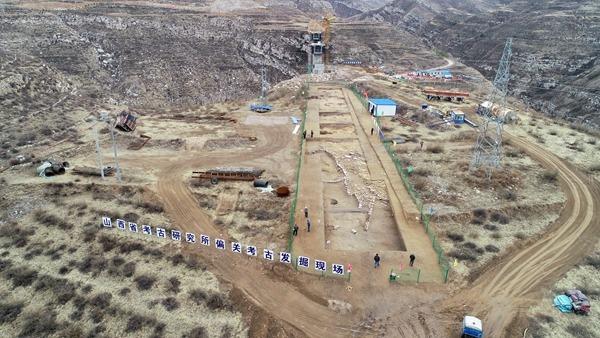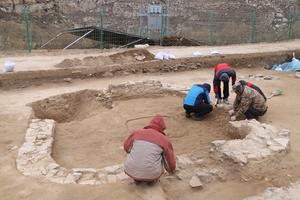Remains of fort on Yellow River bank found, report Sun Ruisheng in Taiyuan and Li Yang in Beijing.
 An aerial view of the Tianfengping excavation site in Pianguan county, Shanxi province, where archaeologists of the Shanxi Archaeology Institute are working. (PHOTO PROVIDED TO CHINA DAILY)
An aerial view of the Tianfengping excavation site in Pianguan county, Shanxi province, where archaeologists of the Shanxi Archaeology Institute are working. (PHOTO PROVIDED TO CHINA DAILY)
"This is the oldest stone stronghold (ruins) we have found in Shanxi province," says Zhang Guanghui, a researcher of Chinese civilization with the Shanxi Archaeology Institute.
The site he was referring to is called Tianfengping by locals in Pianguan county of Shanxi, and is perched on the top of a mountain embraced by a river on three sides.
Covering an area of about 30,000 square meters, the site consists of the remains of four sections of basement walls, 20 building foundations, more than 30 stove pits and two tombs.
The archaeological excavation of the site lasted from September last year to August. Lab tests of pottery indicate that the stronghold or fort was built about 4,500 years ago.
The archaeologists found that the fort went through various stages: construction, abandonment, rebuilding and another phase where it was abandoned again.
Among the foundation ruins, probably for homes, about 10 are comparatively complete. They were built with stones, and consist of interconnected as well as separate rooms. In front there is a square.
The builders took full advantage of the natural landscape to make the stronghold easy to hold and hard to attack. The layout of these rooms, and the overall structure of the complex have remained largely unchanged over the years of their existence. It is estimated hundreds of people lived in the settlement in its heyday.
Located on the east bank of the Yellow River, the Pianguan county, where the ruins were found, is at the northwest corner of Shanxi neighboring the Inner Mongolia autonomous region to its north and Shaanxi province to its west.
The region has been at a crossroad of civilization exchanges involving different ethnic groups, including the Han, Mongolian and Hui peoples. That's why several ruins of similar mountaintop strongholds such as Tianfengping have been found where Inner Mongolia and Shaanxi meet.
Yet, Tianfengping is the first site of its kind excavated in Pianguan. Zhang Guangshui says: "The discovery of Tianfengping fills Pianguan's vacancy for stone forts of that era. It provides firsthand clues and materials for archaeological research on the development of civilization during that period of time in the northwest of Shanxi on the east bank of the Yellow River."
 Archaeologists from the Shanxi Archaeology Institute work to clean what is considered to be foundation ruins for homes built 4,500 years ago in Pianguan county, Shanxi province. (PHOTO PROVIDED TO CHINA DAILY)
Archaeologists from the Shanxi Archaeology Institute work to clean what is considered to be foundation ruins for homes built 4,500 years ago in Pianguan county, Shanxi province. (PHOTO PROVIDED TO CHINA DAILY)
The closest hamlet to the site is Tianfengping village, home to about 300 farmers who live a hand-to-mouth life. They plant millet and beans.
Yang Liuzhen, a 59-year-old villager of Tianfengping, says life is simple here. He often takes a break from his arduous farm work on the top of the mountain where the ruins are located near his farmland.
"I often take a break there. It is a place with good views," Yang says.
Yang often played with other children on the top of the mountain when he was young. "I didn't know it used to be home to people more than 4,500 years ago," he says.
Even the senior residents in the village had no idea of the secrets hidden there, the villagers say.
Yang was employed by the archaeologists to remove the surface dust from the mountain top. "To my surprise, I soon found bones and ceramic chips," says Yang.
A road was built connecting the village with the outside world in 2018, shortening the time it took villagers to travel 15 kilometers from one day to half an hour.
Zang Jianying, head of the Tianfengping township authority, says the discovery of the site is actually a "consequence" of the road, as it was found by the builders.
"The excavation was then approved by the National Cultural Heritage Administration," says Zang.
The villagers hope the development of the site in the future can help to bring them more visitors and boost tourism.
Contact the writers at liyang@chinadaily.com.cn


